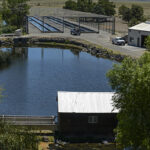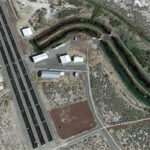July 20, 2020

Black Rock Hatchery, Inyo County
Three California Department of Fish and Wildlife (CDFW) fish hatchery facilities in the eastern Sierra and Southern California have been battling a bacterial outbreak that has affected 3.2 million fish. This week, after consultation with fish pathology experts and exhausting all avenues of treatment, CDFW announced that the fish, which are all trout, at the affected facilities must be euthanized in order to stop the spread of the outbreak.
The affected facilities – Mojave River Hatchery, Black Rock Hatchery and Fish Springs Hatchery – usually provide fish for stocking waterways in CDFW’s South Coast Region and Inland Deserts Region. The euthanization of all the fish at these facilities will have a profound effect on CDFW’s ability to stock fish for anglers in those regions in the near future.
“Euthanizing our hatchery stocks was not a decision we came to lightly, but it had to be done,” said Jay Rowan environmental program manager for CDFW hatcheries. “This bacterium is resistant to all the treatment options we have available for fish. The fish losses were getting worse despite our treatments. The best option we have available that will get us back to planting fish from these hatcheries in the shortest timeline is to clear the raceways, thoroughly disinfect the facilities, and start over.”

Fish Spring Hatchery, Inyo County
CDFW has had the three facilities under quarantine for more than a month, while pathologists and hatchery staff treated the affected fish and researched potential options. The outbreak of Lactococcus garvieae, which is similar to streptococcus, has been reported in cattle and poultry farms as well as fresh and salt water fish and shellfish hatcheries around the world, but had never before been detected in fish in California. Research of treatment options employed at trout farms in Europe and other parts of the world show there is almost no chance for successfully eliminating the bacteria from a facility without depopulation and disinfection.
Fish that are infected with Lactococcus garvieae can show symptoms including bulging eyes, lethargic or erratic swimming and increased mortality, or be asymptomatic and show no signs of infection depending on a several factors including water temperature and stress. Fish-to-human transmission of this bacteria is rare and unlikely but there are several documented instances associated with immunocompromised people consuming infected raw fish and unpasteurized milk products.

Lactococcus garvieae
Hot Creek Hatchery in the eastern Sierra has tested negative for the bacteria and is still planting eight waters in Inyo and Mono counties. CDFW is in the process of developing a modified stocking plan to reallocate fish from central and northern California hatcheries to a small number of high angler use, easily accessible waters in geographically distinct parts of the eastern Sierra and Southern California.
For real-time updates, California anglers can refer to CDFW’s Fish Planting Schedule. This schedule is updated directly by CDFW hatchery staff. Although it contains current information, all fish plants are subject to change depending on road, water, weather and operational conditions.
For additional information, please see CDFW’s frequently asked questions about the L. garvieae outbreak. Also, members of the public can email questions to [email protected].


















Several years ago when “Whirling Disease” infected Mt. Whitney hatchery, prisoners processed the trout and it was distributed into the state prison system to feed prisoners. Depending on the size of the fish, this practice should be considered to spare as much waste as possible. Also, local businesses and chamber… Read more »
Hi Donald,
Just sent you a facebook message. Would love to get you perspective for a story I’m working on.
Will
Time to shut down ALL fishing in the Eastern Sierra. With no more planting this year and possibly next, it will not take long before there will not to be any fish left in these waters, including any leftovers from long ago that might still be able to reproduce. If… Read more »
Here is a link to Fish Springs https://wildlife.ca.gov/Fishing/Hatcheries/Fish-Springs/History. It says that there are 2 wells that provide the Hatchery Waters. There was a third well installed but has not been in operation as the water was of questionable quality. I believe Black Rock Hatchery waters are also from wells. While… Read more »
Fish Springs constantly flows through the hatchery from the wells and into local canals. Trout require fresh cool moving water.
What’s the likelihood of this bacteria infecting local waterways that the hatcheries discharge into?